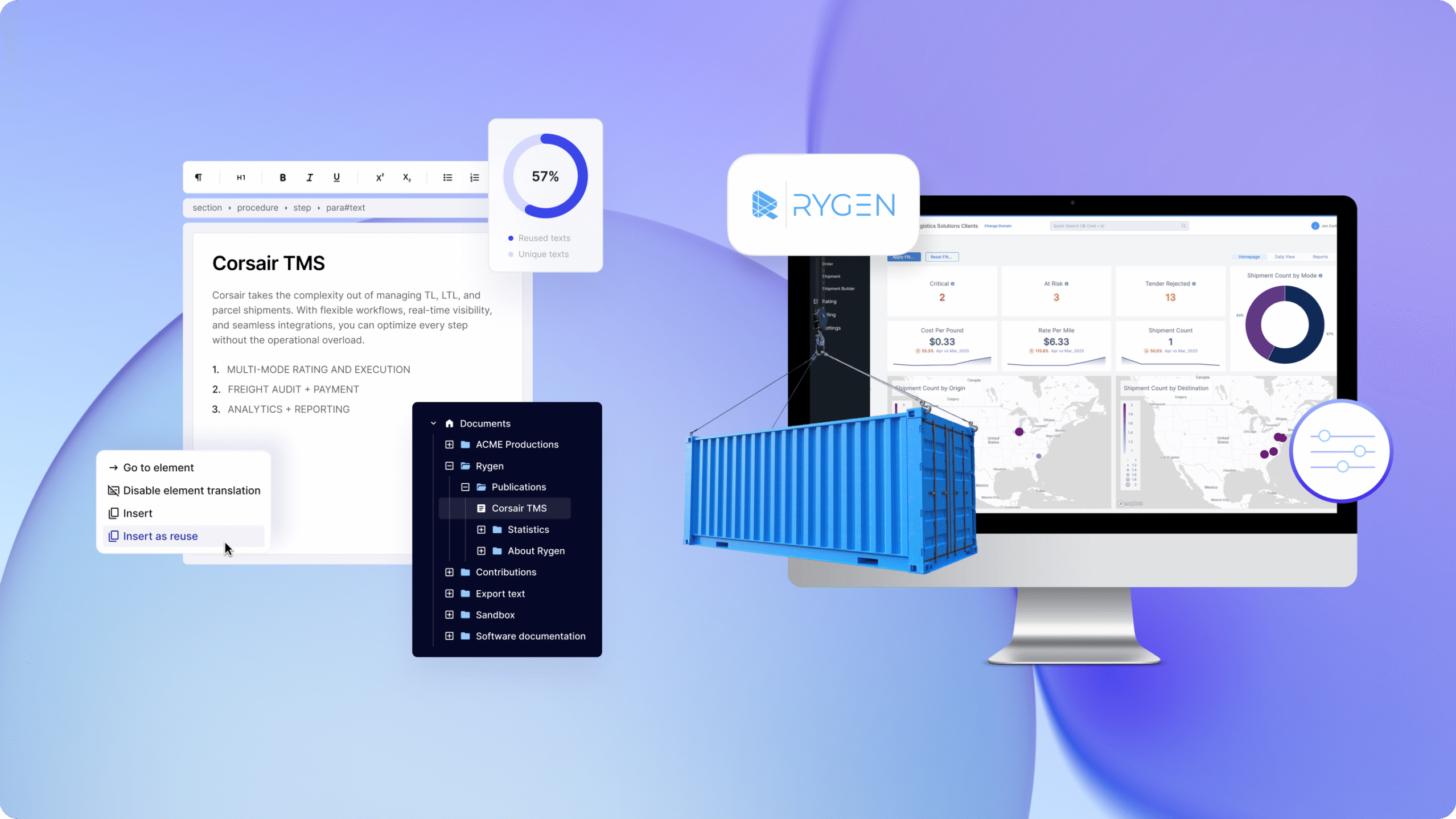- Home
- Rygen Attains 70% Content Reuse with Paligo CCMS
Rygen Attains 70% Content Reuse with Paligo CCMS

Rygen Technologies is a leading provider of state-of-the-art supply chain solutions that empower users to quickly, easily, and efficiently execute and manage freight, connect with partners, and seamlessly integrate with other operating systems. By leveraging advanced technology, the company is creating smarter, data-driven solutions, supported by excellent customer service to deliver real value.
Like every company, strong product documentation was a necessity. That’s where Jason Dailey came in.
Kickstarting Customer Documentation
When Jason Dailey joined Rygen two years ago, there was no customer-facing documentation for the company’s two products, so he was tasked with building it.
Dailey knew that as a one-person team, efficiency was paramount. He began reviewing the products to understand how they functioned. As he did, he documented his notes in Confluence, creating a detailed map of how each product functioned.
I quickly realized that as the UI evolves with new features and different design ideas over time, it was going to be challenging trying to keep up with all of those changes. In fact, it would probably end up a full-time job for me, just doing nothing but tracking down every occurrence of a procedure.
Dailey began researching potential authoring tools to assist him. He did look at content management systems, but they didn’t provide the content reuse capabilities that he knew he needed. What he did need was a component content management system (CCMS). So he started shopping around and narrowed his choices down to two platforms, one of which was Paligo CCMS.
Making the case for Paligo CCMS
From the start, Dailey said Paligo’s customer experience was “head and shoulders” above anyone else. He was impressed with the authoring tool, finding it very intuitive, and he realized this was the solution he needed.
Getting management on board wasn’t difficult. Rygen is a young but growing company, and as it transitioned out of start-up mode and took on new customers, Dailey knew things would get busy. If they didn’t have a CCMS and adopt a content reuse strategy, there would be a lot of manual updates to the documentation, which would take a great deal of his time. And he didn’t have time to constantly chase down where a piece of content was reused and make changes.
If the company didn’t want to increase headcount on the documentation team and wanted Dailey to work as efficiently as possible, a CCMS wasn’t even a debate. And his boss understood and trusted his decision to select Paligo as their CCMS.
With management on board, Dailey moved quickly to implement Paligo CCMS. It took six weeks from the selection of Paligo to the signing of the contract, and from there, it took Dailey about a week to get comfortable using it before he started creating content.
Implementing Paligo CCMS and Content Reuse
Dailey created an admin guide for each product directly in the CCMS using the information he documented in Confluence. The guides are published as web pages to a Rygen Help Center using Paligo’s Help Center template (with some custom CSS the company implemented for branding purposes). He manages 150 pages in Paligo across both products and is now working on a video library for the Help Center.
As a small company and a one-person technical documentation team, Dailey spends 90% of his time working in Paligo. He self-edits and reviews his content, running it by a subject matter expert to ensure it’s technically accurate through a series of short weekly meetings.
As for content reuse, it wasn’t something he had done in other companies he had worked at.
I’ve worked for some years as a technical writer in different organizations, and it never came up. Whether it was me working alone or with a large team of other writers. No one really was talking about it for a long time. When content had to be updated, and it was in all kinds of different places, you just had to roll up your sleeves and do it manually, and no one really thought any better of it. And then all of a sudden, this idea I realized of content reuse, just turned on the light bulb, and I thought, where’s this been all these years?
Dailey had to learn how to do content reuse from scratch. He did extensive reading and research on the subject, learning a great deal from Paligo’s blog content. He also had help from Paligo’s customer success team and video training. Today, approximately 70% of the content is reused across publications.
Start with the Basics and Grow From There
Now that Rygen is growing and directing more people to the Help Center, Dailey plans to integrate Google Analytics to start analyzing its usage. He wants to identify deficiencies in the help content to ensure they deliver the best information possible to customers. He also wants customers to make use of the feedback option to help him ensure the content is truly useful.
In addition, Rygen has hired a Customer Success Manager to handle customer support tickets, and Dailey plans to work with the manager to identify any particular issues that are generating a high volume of tickets. This information will also help him identify which help pages may require further improvement.
Rygen’s story is one of a company just getting started with external customer documentation, and that means focusing on getting the basics in place first. The basics include a place to create and manage documentation as efficiently as possible. There are no requirements for translations, collaborative workflows, variants, or filtering and profiling. And that’s fine. What Rygen and Dailey know is that when that time comes, they have Paligo CCMS to help them. They invested in a tool that can grow and scale with them.
Some Advice for Others
Dailey offered this advice for others thinking of moving to a CCMS and leveraging content reuse:
If you’re in a situation similar to mine, where you have either a one-person team or maybe a very small team, but you have a lot of help content to create or reuse – procedure steps, images, notes, all this kind of stuff – look no further. I would say, you absolutely have to use this product.
As a satisfied and happy customer of Paligo, I have countless examples I could provide from someone who’s been using it for two years, of everything from ease of use, the way the authoring tool is set up, to the support being amazing.
Stay ahead in structured content
Get the Paligo Pulse once a month.

